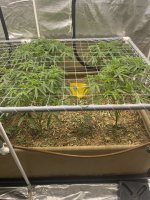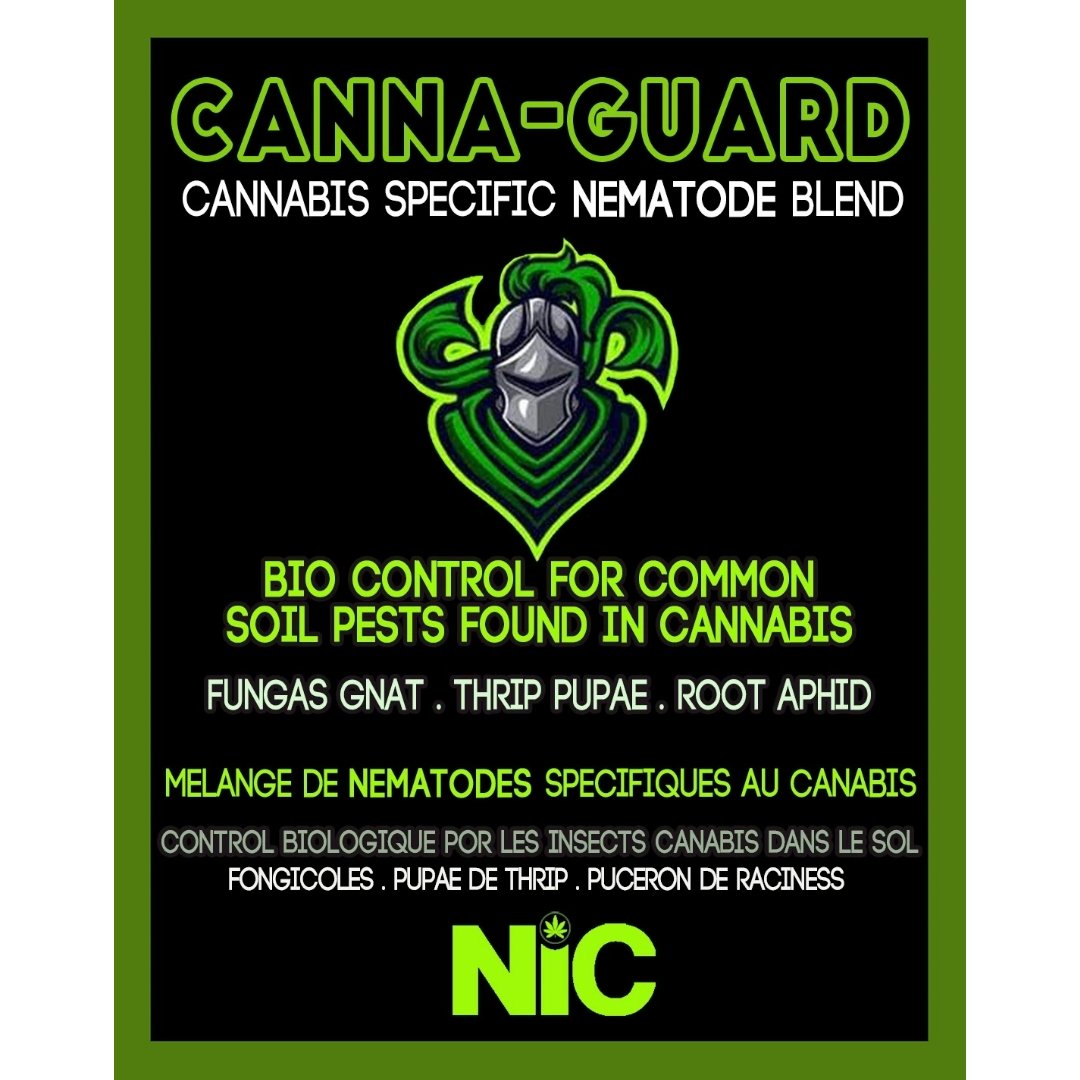Cradle of Mirth
In Bloom
This is not a guide to the only way of managing Fungus Gnats. It is just secondhand knowledge to be shared. If such a thread exists already with these methods I am sorry for duping it, or if this belongs within a certain thread please let me know! I've seen sand mentioned often but never really specific for example.... this is about sand and biocontrols with regard to fungus gnats.
So the gnasty gnats, yeah.
They will commonly give your plant pathogens when they nibble on the roots or plant in general once they really get established, you want to watch that crop closely if you just recovered from or are in the process of dealing with gnats. Just to be safe.
These pests are TMV bullets and can evolve past 17+ generations in a single grow, and they get better at it, evolving into superpests if exposed to harsh conditions and they are allowed to bounce back. For example, if your aggregate contains neem or karanja cake or you use it as a tea, they can adapt to that and many other things including the cold, if they bounce back. Their dormancy mechanisms can change. Worse they can make it outside and go crazy for a summer, backcrossing themselves to old generations and find their way back in with soil the next winter ready to spread more vectors. Unless your winters are cold enough to kill them off outside from storebought soil that gave you them or whatever, they'll keep coming back. If you're winters are cold enough, just don't give them a home inside again to feed on soil life or lay eggs in moist spots.
Coarse sand is really all you need. and
The solutions can be simple without allot of money if you can find coarse sand (not play sand)
We need to mitigate our accessible areas of moisture, control it, simplify it if possible. Prevent them from getting into the soil foremost. Locking them in with a biocontrol of some kind after established, and preventing adults from making new homes in stuff like rice hulls, straw, fabric folds, between the linings of pvc pipe and fabric, in pvc pipe, bamboo, behind plastics against surfaces, inside wheels....some of these things are fine they will just die but some are more likely to be in contact with moisture or sticking out of soil. So using a lure to help control the hatched population.
+Coarse sand for protection/prevention if you know you're prone to them.
-----It has to be coarse or you'll suffocate your soil bed and have a hydrophobic surface.
-----If you can't buy coarse sand, you can sift Sankrete All Purpose Sand with a colander (wear a mask). Hardwares store have that stuff.
+Rove beetles if you have them already + Coarse sand
-----Let the rove beetles establish, then lock it all in with sand. Keep any adult gnats from from getting back in to lay more, and prevent any escapee's from using their new wings.
-----Rove beetles, as larvae & adults, make a feast of Fungus Gnat larvae, they'll take care of shore flies and thrips too.
-----If using Steinernema feltiae they can affect the Rove Beetle larvae population too (If I remember right).
+Adult Gnat Lure:
-----8:2:1 Water:Vinegar:Sugar solution with a little bit of scent free dish soap will lure adults flying around.
-----So for example 1/2 C. H2O, 2TBSP vinegar, 1TBSP sugar, 5-7 drops of dish soap.
~+Nematodes if you can't get rove beetles and don't plan on it.
-----Steinernema feltiae, its a great hunter, some nematodes camp out and are effective too but I believe these are best. Make sure to water them in good.
=====================================================
I need to emphasise coarse again.
Like this, even with some smaller or bigger pieces, you want it breathable:
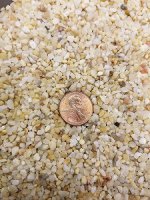
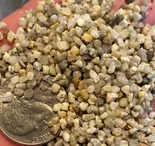
==============================================
How to use the coarse sand this particular way and notes on pots:
Use a thin layer on top, it'll vary between 1/4 and half an inch in depth. If you spot gnats somehow crawling out of an area, put more.
----Put it in the bottom channels/grooves of your trays if they have them, maybe even just fill it in so no plastic shows at the bottom. The goal is to prevent freestanding water areas that are bound and meant to have water...
-----Refrain from using plastic pots with holes high up on the sides, in fact, consider using no bottoms for smaller pots and having them sunk into the sand a bit, it will promote better breathing too. Another option is to just fill a layer of the bottom of a pot already set in a permanent spot, cause the sand will pour out.
Place bucket pots that have drain holes, anything with drain holes that is accessible to a gnat, over course sand sunken in a bit with a little berm along the perimeter of the pot. We don't want any holes anywhere that a gnat can access soil or moisture happily. Gnats aren't happy on moist coarse sand that drys out every few days.
-----Roots will grow out into this sand and air prune, let it dry out between waterings so it doesn't fester, you can water them from there mainly too so you don't have to be careful top watering. At least soak the top surface a little keeping it hydrated I think it helps with hydrostatic pressure so it should drink it in from the bottom easier, unless not deep enough in the sand
-----Rice hulls are great and have silica, you can even turn them to ash for like 85% silica with potash too of course... but I've seen with my own eyes gnats break through 1", 3" and 5" inch thick rice husk layers, coming up from the soil, trying to escape rove beetles as they've hatched... they even make condominiums out of hulls or straw, adults just meander their way slowly down until they find moisture to drop the next gen of newly adapted armies. If you use rice husk, just use them as a mulch, mix it in, cover that as usual with coarse sand.
-----When you have to amend, get a putty knife or flat cement trowel and scrape back your layer of sand avoiding soil, then scrape back to the other side the stuff likely to have soil mixed in, amend, reverse the process.
Pot design:
If you use fabric pots or beds with pvc, they like to shift and make coarse sand complicated:
-----For fabric beds, make sure they are filled to the pvc brim, if your bed is a rectangle shape, reinforce the center with another joint as a crossbar so it is rigid.
-----For fabric pots, you kind of just have to not wiggle them around or mess with them, and if you know you have to be ready to fix or add more sand.
-----Along the bottom of fabric pots is a great place for wiggling writhing nasties so, use coarse sand.
-----Make sure all pvc ends are capped
Like I said don't use pots with holes going up along the sides as great some of them are, and the many types of air pruning pots available. But fabric pots like Ac infinity, Rootpouch, Smartpots, and Sustainable village for example, I feel are fine enough that gnats can't get through, though I have seen gnats somehow use the cracks of closed velcro for laying if in contact with soil. i have seen fungus gnat larvae scaling wet fabric surfaces no different though but only in infestations that weren't under control yet, and was from the basin the fabric pot was in. They did not have 1/4-1" of coarse sand at the bottom of the basin for such a large pot, no sand at all so it was where they kept coming back from each time they thought it was under control, or in the cores of woven basket reed/vine used as air pots, etc.
Keep your pots simple top and bottom, whatever way know where surfaces meet with moisture and can lead to moisture, and if something can have sand to block entry but can't be sealed either, rubberband or tie a breathable material like nylon/acrylic mesh teabags over things like pvc ends that need to be open or purchase it milspec.
[Which brings me to an idea for experimentation/possible solution if you can sew and have the time to source material of proper mesh size, breathable, probably black so no green algae grows on it, instead of coarse sand for the fabric pot soil surfaces. Something that is fitted over the top and around the pot like a neck gaiter going 1/4 to halfway down the pot, with snug overlaping seal, and around the plant stock it can be sinched up snug with an elastic material so it can safely gain girth and it can be loosened with time- it could be opened to be watered or just have it loose enough that you can water over it directly for a slow trickle. ]
Notes on stuff like RECYCLED (infested), nursery, store bought or outdoor soil, compost etc, especially vegan plant based compost:
Their all prone to introducing some other regions gnats or just local gnats that got in. If you know its fresh stuff and trust the vendor, you can just use it straight i'm sure and get away with it just use the coarse sand right from the start if you've dealt with gnats before. If any exist they'll be trapped when they break dormancy, go through their life cycle and be digested by the soil life.
But if you're worried you can sterilize the soil, like with the sand for 25min. Re-inoculating with the same unsterilized bag of media or outside soil media - by making a tea from it and passing it through a screen fine enough to catch gnat eggs but not things like trichoderma, S. Feltiae, and all those smaller beneficial microbes. Wouldn't hurt to add worm castings to the tea.
Or you can buy some kind of diverse product that has allot of life from feather meal, insect frass and such. Down to earth as a good dry innoculant thats pretty wide spectrum, not just endomycorrhizal's but also ecto's and other things. You can add in neem and karanja cakes into your aggregate or top dress it if you know you don't already have an infestation, don't go crazy it can affect beneficials. Let that soil sit a few weeks with its safety net (the coarse sand) and it will be alive and safe for the most OCD.
If you worry about introducing things to a bed, you can do this for open bottom plug pots you wish to transplant in the future, and if not sterilized you can still count on the sand barrier between the beds surface and bottom of plug pot even if the plug pot is infested for example but i wouldn't risk that without a extra thick layer of course sand. The roots will grow through it. When you set one of these open bottom pots onto a bed or bigger pot, this is the time you would apply a direct beneficial endomyco specific to the plant like Dynomyco, Supercharge, Mycogrow endo. or just be happy with the likely sufficient life already there to plug into, and the bed will use what you put inside the plug pot. Everything is self contained in terms of gnat penetration.
Sterilizing for large volumes of soil is not easy though and living soil is mostly for 5 gallons and up I feel like. but I feel like the diversity is needed to help battle other things aside from gnats that can sporulate or breed in the sterile soil from the air and so might as well treat smaller pots no differently so something in the air like pythium etc doesn't find itself without competition.
Note on other biocontrol that's great but risky if bought immature with food source or as adults with food source included:
Green Lacewings are a great solution for adult fungus gnats flying around and on the surface or anywhere. However, they are typically delivered with a food source, without naming big ag companies lets just say they are prone to having broad mites and stuff like that in the food source with the eggs by accident, opening you up to bigger issues and they can make your plant look like it has a pathogen before you even discover them. Just for using one biocontrol to take care of Fungus Gnats you now have more problems. Like wiping your plants with the bottom of a broom. Don't apply these lacewing "cards" and such directly to your plants, have sacrificial plants, any kind of plant, quarantined in its own little safe space (like a milk jug with small part of top cut off, but in the same room and no strong air flow). Lowering the potential risk of something like broadmites from transfer to your stock garden. just make sure hatched lacewings can escape and pick up stronger scents from the living soil outside.
Gnats will make it into this sacrificial quarintined pot too and try to breed, so beware, use sand. By the time the lacewings hatch, go through a 12 day feeding cycle then cocoon and blossom into a flying identifiable adult lacewing - fungus gnats will have found and be using that quarantine as their last ditch effort for a new generation cycle to continue unless soil is protected with sand, you have to be careful. You want to keep the lacewing cards in the branches away from the soil surface.
Basically, if possible, just buy these as adults without a food source in transit.
There are highly diverse products you can apply with nematodes and everything from protazoa etc that will create a battlefield fungus gnats can't survive, incredible products, but they are difficult to acquire or expensive. Coarse sand, no fine particles. Cheers!
Here's a picture of Fungus Gnat larvae underwater. Something coarse sand and Rove Beetles can't help you with.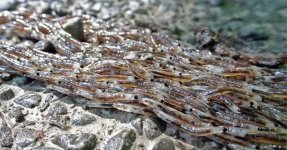
Larvae in a nasty tray gutter, sand that does get dirty with soil matter should be rinsed out in time too. For other reasons among gnats.
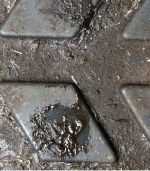
So the gnasty gnats, yeah.
They will commonly give your plant pathogens when they nibble on the roots or plant in general once they really get established, you want to watch that crop closely if you just recovered from or are in the process of dealing with gnats. Just to be safe.
These pests are TMV bullets and can evolve past 17+ generations in a single grow, and they get better at it, evolving into superpests if exposed to harsh conditions and they are allowed to bounce back. For example, if your aggregate contains neem or karanja cake or you use it as a tea, they can adapt to that and many other things including the cold, if they bounce back. Their dormancy mechanisms can change. Worse they can make it outside and go crazy for a summer, backcrossing themselves to old generations and find their way back in with soil the next winter ready to spread more vectors. Unless your winters are cold enough to kill them off outside from storebought soil that gave you them or whatever, they'll keep coming back. If you're winters are cold enough, just don't give them a home inside again to feed on soil life or lay eggs in moist spots.
Coarse sand is really all you need. and
The solutions can be simple without allot of money if you can find coarse sand (not play sand)
We need to mitigate our accessible areas of moisture, control it, simplify it if possible. Prevent them from getting into the soil foremost. Locking them in with a biocontrol of some kind after established, and preventing adults from making new homes in stuff like rice hulls, straw, fabric folds, between the linings of pvc pipe and fabric, in pvc pipe, bamboo, behind plastics against surfaces, inside wheels....some of these things are fine they will just die but some are more likely to be in contact with moisture or sticking out of soil. So using a lure to help control the hatched population.
+Coarse sand for protection/prevention if you know you're prone to them.
-----It has to be coarse or you'll suffocate your soil bed and have a hydrophobic surface.
-----If you can't buy coarse sand, you can sift Sankrete All Purpose Sand with a colander (wear a mask). Hardwares store have that stuff.
+Rove beetles if you have them already + Coarse sand
-----Let the rove beetles establish, then lock it all in with sand. Keep any adult gnats from from getting back in to lay more, and prevent any escapee's from using their new wings.
-----Rove beetles, as larvae & adults, make a feast of Fungus Gnat larvae, they'll take care of shore flies and thrips too.
-----If using Steinernema feltiae they can affect the Rove Beetle larvae population too (If I remember right).
+Adult Gnat Lure:
-----8:2:1 Water:Vinegar:Sugar solution with a little bit of scent free dish soap will lure adults flying around.
-----So for example 1/2 C. H2O, 2TBSP vinegar, 1TBSP sugar, 5-7 drops of dish soap.
~+Nematodes if you can't get rove beetles and don't plan on it.
-----Steinernema feltiae, its a great hunter, some nematodes camp out and are effective too but I believe these are best. Make sure to water them in good.
=====================================================
I need to emphasise coarse again.
Like this, even with some smaller or bigger pieces, you want it breathable:


==============================================
How to use the coarse sand this particular way and notes on pots:
Use a thin layer on top, it'll vary between 1/4 and half an inch in depth. If you spot gnats somehow crawling out of an area, put more.
----Put it in the bottom channels/grooves of your trays if they have them, maybe even just fill it in so no plastic shows at the bottom. The goal is to prevent freestanding water areas that are bound and meant to have water...
-----Refrain from using plastic pots with holes high up on the sides, in fact, consider using no bottoms for smaller pots and having them sunk into the sand a bit, it will promote better breathing too. Another option is to just fill a layer of the bottom of a pot already set in a permanent spot, cause the sand will pour out.
Place bucket pots that have drain holes, anything with drain holes that is accessible to a gnat, over course sand sunken in a bit with a little berm along the perimeter of the pot. We don't want any holes anywhere that a gnat can access soil or moisture happily. Gnats aren't happy on moist coarse sand that drys out every few days.
-----Roots will grow out into this sand and air prune, let it dry out between waterings so it doesn't fester, you can water them from there mainly too so you don't have to be careful top watering. At least soak the top surface a little keeping it hydrated I think it helps with hydrostatic pressure so it should drink it in from the bottom easier, unless not deep enough in the sand
-----Rice hulls are great and have silica, you can even turn them to ash for like 85% silica with potash too of course... but I've seen with my own eyes gnats break through 1", 3" and 5" inch thick rice husk layers, coming up from the soil, trying to escape rove beetles as they've hatched... they even make condominiums out of hulls or straw, adults just meander their way slowly down until they find moisture to drop the next gen of newly adapted armies. If you use rice husk, just use them as a mulch, mix it in, cover that as usual with coarse sand.
-----When you have to amend, get a putty knife or flat cement trowel and scrape back your layer of sand avoiding soil, then scrape back to the other side the stuff likely to have soil mixed in, amend, reverse the process.
"You can sterilize the sand in a pressure cooker, i'm not liable for anything, but if you worry about the life on it, it will have microscopic critters... They aren't commonly bad but if worried, or potential of pathogens if it came from a anaerobic spot or simply smells gross like some wet sand smells of weird pee... Fill a bowl of coarse sand lightly wet it, rinse it if you want to in a colander first, then using the pots metal tray at the bottom, fill with water up to the tray where bowl will rest, put your bowl on that and pressure cook 25 min on high (for instapots). "
Pot design:
If you use fabric pots or beds with pvc, they like to shift and make coarse sand complicated:
-----For fabric beds, make sure they are filled to the pvc brim, if your bed is a rectangle shape, reinforce the center with another joint as a crossbar so it is rigid.
-----For fabric pots, you kind of just have to not wiggle them around or mess with them, and if you know you have to be ready to fix or add more sand.
-----Along the bottom of fabric pots is a great place for wiggling writhing nasties so, use coarse sand.
-----Make sure all pvc ends are capped
Like I said don't use pots with holes going up along the sides as great some of them are, and the many types of air pruning pots available. But fabric pots like Ac infinity, Rootpouch, Smartpots, and Sustainable village for example, I feel are fine enough that gnats can't get through, though I have seen gnats somehow use the cracks of closed velcro for laying if in contact with soil. i have seen fungus gnat larvae scaling wet fabric surfaces no different though but only in infestations that weren't under control yet, and was from the basin the fabric pot was in. They did not have 1/4-1" of coarse sand at the bottom of the basin for such a large pot, no sand at all so it was where they kept coming back from each time they thought it was under control, or in the cores of woven basket reed/vine used as air pots, etc.
Keep your pots simple top and bottom, whatever way know where surfaces meet with moisture and can lead to moisture, and if something can have sand to block entry but can't be sealed either, rubberband or tie a breathable material like nylon/acrylic mesh teabags over things like pvc ends that need to be open or purchase it milspec.
[Which brings me to an idea for experimentation/possible solution if you can sew and have the time to source material of proper mesh size, breathable, probably black so no green algae grows on it, instead of coarse sand for the fabric pot soil surfaces. Something that is fitted over the top and around the pot like a neck gaiter going 1/4 to halfway down the pot, with snug overlaping seal, and around the plant stock it can be sinched up snug with an elastic material so it can safely gain girth and it can be loosened with time- it could be opened to be watered or just have it loose enough that you can water over it directly for a slow trickle. ]
Notes on stuff like RECYCLED (infested), nursery, store bought or outdoor soil, compost etc, especially vegan plant based compost:
Their all prone to introducing some other regions gnats or just local gnats that got in. If you know its fresh stuff and trust the vendor, you can just use it straight i'm sure and get away with it just use the coarse sand right from the start if you've dealt with gnats before. If any exist they'll be trapped when they break dormancy, go through their life cycle and be digested by the soil life.
But if you're worried you can sterilize the soil, like with the sand for 25min. Re-inoculating with the same unsterilized bag of media or outside soil media - by making a tea from it and passing it through a screen fine enough to catch gnat eggs but not things like trichoderma, S. Feltiae, and all those smaller beneficial microbes. Wouldn't hurt to add worm castings to the tea.
Or you can buy some kind of diverse product that has allot of life from feather meal, insect frass and such. Down to earth as a good dry innoculant thats pretty wide spectrum, not just endomycorrhizal's but also ecto's and other things. You can add in neem and karanja cakes into your aggregate or top dress it if you know you don't already have an infestation, don't go crazy it can affect beneficials. Let that soil sit a few weeks with its safety net (the coarse sand) and it will be alive and safe for the most OCD.
If you worry about introducing things to a bed, you can do this for open bottom plug pots you wish to transplant in the future, and if not sterilized you can still count on the sand barrier between the beds surface and bottom of plug pot even if the plug pot is infested for example but i wouldn't risk that without a extra thick layer of course sand. The roots will grow through it. When you set one of these open bottom pots onto a bed or bigger pot, this is the time you would apply a direct beneficial endomyco specific to the plant like Dynomyco, Supercharge, Mycogrow endo. or just be happy with the likely sufficient life already there to plug into, and the bed will use what you put inside the plug pot. Everything is self contained in terms of gnat penetration.
Sterilizing for large volumes of soil is not easy though and living soil is mostly for 5 gallons and up I feel like. but I feel like the diversity is needed to help battle other things aside from gnats that can sporulate or breed in the sterile soil from the air and so might as well treat smaller pots no differently so something in the air like pythium etc doesn't find itself without competition.
Note on other biocontrol that's great but risky if bought immature with food source or as adults with food source included:
Green Lacewings are a great solution for adult fungus gnats flying around and on the surface or anywhere. However, they are typically delivered with a food source, without naming big ag companies lets just say they are prone to having broad mites and stuff like that in the food source with the eggs by accident, opening you up to bigger issues and they can make your plant look like it has a pathogen before you even discover them. Just for using one biocontrol to take care of Fungus Gnats you now have more problems. Like wiping your plants with the bottom of a broom. Don't apply these lacewing "cards" and such directly to your plants, have sacrificial plants, any kind of plant, quarantined in its own little safe space (like a milk jug with small part of top cut off, but in the same room and no strong air flow). Lowering the potential risk of something like broadmites from transfer to your stock garden. just make sure hatched lacewings can escape and pick up stronger scents from the living soil outside.
Gnats will make it into this sacrificial quarintined pot too and try to breed, so beware, use sand. By the time the lacewings hatch, go through a 12 day feeding cycle then cocoon and blossom into a flying identifiable adult lacewing - fungus gnats will have found and be using that quarantine as their last ditch effort for a new generation cycle to continue unless soil is protected with sand, you have to be careful. You want to keep the lacewing cards in the branches away from the soil surface.
Basically, if possible, just buy these as adults without a food source in transit.
There are highly diverse products you can apply with nematodes and everything from protazoa etc that will create a battlefield fungus gnats can't survive, incredible products, but they are difficult to acquire or expensive. Coarse sand, no fine particles. Cheers!
Here's a picture of Fungus Gnat larvae underwater. Something coarse sand and Rove Beetles can't help you with.

Larvae in a nasty tray gutter, sand that does get dirty with soil matter should be rinsed out in time too. For other reasons among gnats.

Last edited:
